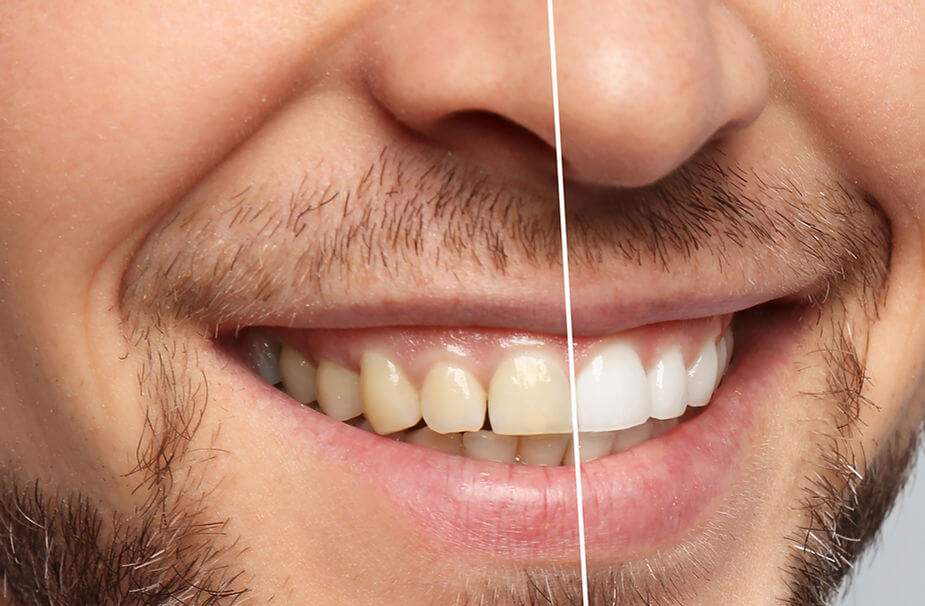Have you ever whitened your teeth? If so, you are not alone. According to Statista, more than 40 million Americans used a tooth whitening product in 2018. That means that nearly 1 out of every 5 adults tried to gain whiter teeth last year.

Tooth whitening is so common that it may never have occurred to you to wonder if it is safe. You may assume that if it is allowed to be sold in stores that must mean it is harmless. What about for kids and teenagers? Is it safe for your 16-year-old? What about for your 10-year-old? Just in case you ever wondered, we have compiled this guide to basic information about how teeth whiteners work and whether they are safe for adults and children.
To understand how they work, it helps to understand what causes teeth to appear discolored. Teeth contain a hard layer of enamel which covers the softer, yellow dentin underneath. With time, a layer of foreign material forms over the enamel. This layer is called a pellicle film.
Extrinsic staining, sometimes called external staining, occurs on the surface of the tooth’s enamel. This staining occurs when various compounds from some foods, beverages, metals, and cigarette smoke are deposited onto the surface of the tooth and into the pellicle film, causing teeth to appear darker. Some of the obvious culprits are coffee, soda, and red wine, but healthy foods like blueberries and tomato sauce can also cause noticeable stains. Excellent toothbrushing technique and rinsing your mouth immediately after consuming these substances can help minimize the staining. However, as time passes, the materials make their way into the porous enamel and cause a deeper stain which is more difficult to remove.
The other type of stain, intrinsic or internal stains, is not caused by foods and foreign materials. Common causes of intrinsic stains are genetic factors, trauma to a tooth, some medications, chemotherapy, head and neck radiation, very high levels of fluoride, and cavities. People also experience yellowing as they age because enamel wears down over time, allowing the yellow dentin to show through and have a greater impact on tooth color.
Tooth whitening refers to any process that lightens the appearance of teeth. They are usually whitened in one of two ways, removing the extrinsic stain or bleaching the intrinsic stain. Many times, extrinsic stains can be lightened quite a bit by a thorough cleaning from your dentist. Abrasive products and micro-abrasion also work by removing the discoloring film over teeth.
Teeth bleaching is often performed through the use of hydrogen peroxide, which is found naturally in the human body and is the active ingredient in many whitening products. Carbamide peroxide, which breaks down into hydrogen peroxide, is also commonly used. They work by diffusing into the tooth and breaking down the dark compounds which results in smaller, less darkly pigmented components.
There are a few different methods for whitening teeth. The easiest is using a whitening toothpaste, which contains more abrasive particles than regular toothpaste, to remove external stains. Some also contain blue covarine, which is a chemical that sits on the surface of your teeth and helps them appear whiter. Other whitening toothpastes contain small amounts of hydrogen peroxide to work on deeper stains.
If you want more obvious results, you can have your teeth professionally whitened by a dentist or use over-the-counter products. OTC whiteners usually involve the use of strips or a gel that you apply to your teeth for a certain amount of time every day for a few days or weeks. These typically use hydrogen peroxide to bleach stains and can be very effective at producing a noticeably whiter smile.
There are two benefits to spending the extra money to have your teeth professionally whitened. First, a dentist can evaluate your mouth and help you decide whether whitening will be effective for you, and what type is best for your situation. They can diagnose and treat underlying problems, such as cavities or damage caused by trauma. Second, professional whitening treatments use much higher amounts of hydrogen or carbamide peroxide and can provide the maximum results in a shorter time period than OTC products. Your dentist will protect your gums with a barrier, so much higher concentrations of carbamide or hydrogen peroxide can be safely used. A dentist may also offer prescription level at-home whitening. In this method, you fill trays that are made to fit your teeth with a bleaching solution then wear the trays for 30 minutes to one hour every day for a few weeks.
Each method varies by the strength of the solution, length of time the treatment takes, the intensity of the results, and the length of time the results last. In-office whitening uses a stronger solution, so it only needs a few sessions to deliver optimal results that will last the longest. Dentist supervised at-home whitening treatment provides the second strongest and long-lasting result. A mix of professional in-office and at-home treatments could potentially lighten teeth by 12 to 15 shades. The next level is OTC whitening treatments, which vary by strength and will deliver different results based on the product, followed by whitening toothpastes which are the mildest treatment and only lighten teeth by one or two shades.
Some companies claim that using certain types of light, alone or alongside other whitening products, will also whiten teeth. Unfortunately, this is not backed by scientific research. It can, however, increase tooth sensitivity (1).

When you follow the product or dentist’s directions and do not overuse whitening products it is safe for adults. The American Dental Association recommends that you speak with your dentist before bleaching teeth and avoid it while you have untreated cavities, broken, chipped, or cracked teeth, or dental work in progress. The most common side effects are tooth sensitivity or inflammation of your gums. Be careful not to get the solution or strips on your gums and you will reduce the likelihood of gum irritation. If your teeth feel sensitive, switch to a milder product or take a break for a few days then try again. People with sensitive teeth may find it helpful to use whitening products once every two or three days, instead of daily.
Some claim that bleaching can harm your enamel. Studies have found that very high concentrations of hydrogen or carbamide peroxide can temporarily soften enamel, but this can be offset by the use of fluoride. These higher concentrations did not cause enamel to erode. However, studies have not determined the effect of whitening treatments on teeth when repeated multiple times in a person’s life.
It is also important to know that teeth bleaching will have varied results based on the cause of the stain. Teeth with gray tones or discoloration due to cavities, medication, or tooth injury will not lighten as well or as uniformly as other teeth. Additionally, patients with visible, enamel-colored caps, crown, veneers, or fillings may not be good candidates for whitening treatments, since these teeth will not change color and could stand out against the natural teeth.
Once all the permanent teeth have erupted, whitening is okay. Dr. Culp recommends that teenagers finish their orthodontic treatment and give their teeth time to settle in for a bit before whitening their teeth. Research does show that adolescents report tooth sensitivity from whitening more often than younger kids or adults do.
Baby teeth have thinner enamel and may appear to be a different color than permanent teeth. This may cause teeth to appear to be different shades as baby teeth fall out and permanent teeth grow in. The American Academy of Pediatric Dentistry discourages cosmetic bleaching of the full arch in children with both primary and adult teeth. The AAPD also recommends that bleaching in young patients should be strictly supervised by an adult under the guidance of a dentist.
We are happy to help you understand the options and discover what is best for your child. If only one or two of your child’s teeth are discolored, we can help determine the cause and provide appropriate advice or treatment for the situation.
Follow all the instructions, and do not leave bleaching products on teeth longer than advised. This will help minimize the risk of tooth sensitivity, gum irritation, and temporarily softened enamel. After you whiten, avoid acidic beverages like soda, sports drinks, and juices for a few hours to protect your teeth.
Keep in mind that tooth whitening is not a one-time thing. Your teeth will need periodic touch-ups. You can keep your teeth whiter by maintaining excellent oral hygiene habits and rinsing your mouth right after eating or drinking items that can stain teeth. Using a straw and avoiding smoking will also help keep your teeth a lighter shade.
If it’s been a while since you’ve had a professional dental cleaning, try that first! Removing surface stains may be enough to provide the results you are looking for. It is also a good idea to have your dentist fill in any cavities and make sure your gums are healthy before using a whitening product.
Teeth whitening is a personal choice, but we are here to help you make an informed decision if anyone in your family is considering whitening their teeth. We are privileged to help you understand the choices and determine the best solution to brighten your smile.

At Jungle Roots Children’s Dentistry & Orthodontics, we strive to provide the highest comprehensive pediatric and orthodontic dental care in a unique, fun-filled environment staffed by a team of caring, energetic professionals. We believe the establishment of a “dental home” at an early age is the key to a lifetime of positive visits to the dentist.
#ahwatukee#Arizona#chandler#children#dental#dentalcare#dentist#dentistry#health#JungleRoots#kids#OralHealth#ortho#orthodontics#PediatricDentistry#phoenix#selfcare#teeth#wellbeing#wellness#whitening

Notifications